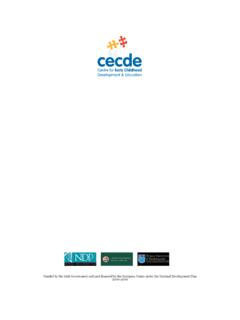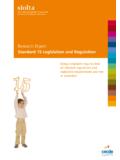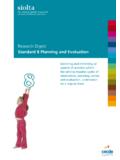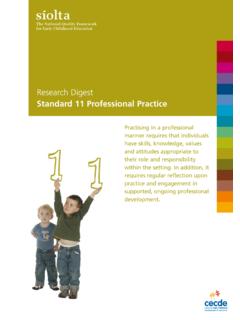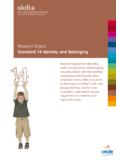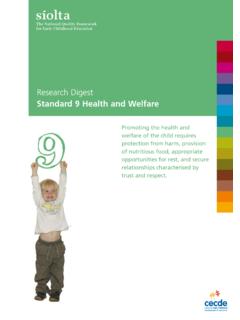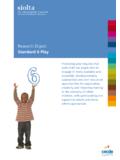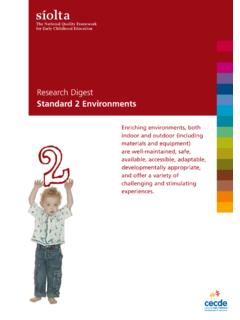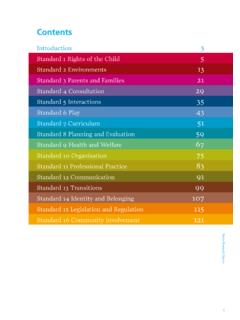Transcription of Research Digest - Síolta
1 The National Quality Framework for Early Childhood Educations oltaResearch Digest Standard 10 OrganisationOrganising and managing resources effectively requires an agreed written philosophy, supported by clearly communicated policies and procedures to guide and determine practice. Research Digest s olta Organisation Research Digest s olta OrganisationIntroductionPhilosophy permeates everything that we do. It is the collective term for the knowledge, beliefs, ideologies, thoughts, values, and principles we attach (either consciously or sub-consciously) to our everyday thought and action processes. When written down and supported by clearly communicated policies and procedures, it is what provides a setting with an effective point from which to organise and manage resources and, thereby, guide and determine and values form the basis of a setting s philosophy. Values describe the standards which a culture, society or individual consider important, while principles provide more detailed standards and expectations, and generate a clearer framework for behaviour.
2 When combined, both help to inform decisions about different courses of action, and provide guidance on standards and expectations in terms of the type and style of early childhood care and education (ECCE) offered. The written statement that emerges from the collective principles and values provides a reminder of what is expected, and is, therefore, what guides the development of good practice. The translation of policies and procedures into practice is highly dependent on effective organisation within a setting. Clearly documented, well-developed and functioning management structures and operating processes should provide the backbone of this organisation. Good management and support mechanisms ensure that policies are actively implemented and yield results which enhance the overall quality of the setting. These mechanisms include relevant stakeholder input, the efficient and effective management of financial resources, support and encouragement of all adults working within the setting, a strong ethos of teamwork, accurate administration records, and opportunities for continuing professional development.
3 Research Digest s olta OrganisationRecent ResearchDocumented vision, values, principles, policies, and proceduresThe most effective early childhood settings are characterised by an articulated philosophy that is collectively shared by all personnel (Taggart, 007). The vision or philosophy of a service is the core message of the organisation s purpose and what it represents. Sometimes referred to as a mission statement, it succinctly relates why the organisation exists and outlines its underlying value system (French, 00 ). The aim of the Centre for Early Childhood Development and Education (CECDE), for example, is to develop and coordinate high quality early childhood education provision in policy contains principles (outlining why the policy is being made), a statement of intent (based on collective beliefs and actions), and corresponding procedures (detailing how those actions will be implemented in the given circumstances) (NIPPA, 00 ). Clearly established policies and procedures in early childhood settings should achieve the following: Demonstrate commitment to professional practice, increase efficiency and cohesion Ensure greater consistency and clarity in communications with stakeholders Enable parents and children to make informed decisions on whether the setting suits their needs Allow for greater participation and sharing of responsibility Prevent being obliged to create a new response every time an issue arises Enhance the standards and quality of the settings (French, 00 ; NIPPA, 00 ; Moloney, 006)Typically, policies and procedures will be developed on admissions, health and safety, confidentiality, supporting diversity, illness, and family participation (Byrne, 00 ; Byrne et al.)
4 , 00 ; French, 00 ; NIPPA, 00 ; Moloney, 006). The vision, principles, policies and procedures must be relevant, meaningful and considered in the context of individual services, not drawn directly from others (French, 00 ). Effective policies and procedures are regularly monitored, reviewed and updated. Updates are generally required in response to new legislation or regulation, a request from a parent, child or staff member, a previous omission, an unforeseen incident, or a change in the organisational structure of the setting (Moloney, 006). Stakeholders (children, parents, staff or other relevant personnel) should be involved in the drafting and regular review of policies and procedures. These need to be clearly articulated and recorded ( Research Digest /Standard 8: Planning and Evaluation) and a system for their dissemination should be developed ( Research Digest /Standard 1 : Communication). All relevant documentation in the service should be translated into the first language of all service users (French, 00 ).
5 According to the Child Care (Pre-School Services) Regulations (Department of Health and Children [DHC], 006), a person operating an early childhood service is required to keep certain records. These include child/family records (register of details in relation to parents/guardians, health details, etc.) and personnel and operational details (details of staff members, facilities, accidents, fire procedures, and policies and procedures in general). Records may include a contract with parents, observations and assessments of children s development and learning ( Research Digests/Standards 6: Play and 7: Curriculum), a compliments book and complaint forms, a waiting list and so forth (French, 00 ). Administration records are kept in order to: Research Digest s olta Organisation Comply with legislation and regulations Deal more effectively with illness and emergencies Write reports and funding proposals within the bounds of confidentiality Ensure finances are adequate and to aid payment of tax/wages/bills (French, 00 ) Implementation of the setting s philosophy Taggart ( 007) reveals that, in the most effective centres for enhancing children s emotional and cognitive development, strong leadership and long serving staff ( , those with over three years service) prevailed.
6 This leadership was characterised by thorough planning, a strong focus on education and the curriculum, an emphasis on the critical importance of adult-child interaction, and staff support. Visionary and dynamic leadership is a key element in the quest for enhancing quality in early childhood settings (Rodd, 006). Leadership and management are different dimensions of the operation of services and are inherently connected. Effective managers plan and set objectives, organise how to meet those objectives, and coordinate, communicate with and inspire individuals and teams to contribute to them. This involves being sensitive and responsive to the needs of staff members, and to the working conditions within the service. Effective managers control, monitor and review performance, and oversee resources. Leaders reflect, give direction, identify new objectives, offer motivation, build teamwork, model what leaders do and gain acceptance of their role. Leadership concerns learning, and so effective leaders are learners (Rodd, 006: ).
7 Management responsibilities involve providing adequate resources for the service to function, such as the maintenance of financial stability. Detailed weekly, monthly and annual records of income and expenditure are required. These can include service fees/grants received (and due), salaries, benefits and tax paid (and due), insurance, rent, light, heat, decorating, maintenance, repairs, telephone rental and charges, recruitment costs, Research Digest s olta Organisation6 Research Digest s olta Organisationadministration costs and every item purchased for the service (French, 00 ).Valuing adults and encouraging teamworkStaff are the most important resource for any service. Ideally, practitioners should be able to identify with the children and families in their care; plan to support children s learning and development; counter inequality; and be motivated to develop their skills and knowledge (French, 00 ). When recruiting staff, thorough selection procedures must be in place (DHC, 00 ).
8 The following sequence of tasks provides an example of an effective, transparent recruitment process: Establishment of terms and conditions Job analysis and job description/specification Advertising (ensuring equal opportunities) Processing applications Interviewing Gathering references Developing personnel files Making the appointment Establishing the contract (detailing a probationary period) InductionValuing staff involves paying appropriate salaries and adhering to employment legislation. As part of good communication and staff supervision, training and development should be assessed, the year s performance should be appraised and a professional development plan should be formulated (French, 00 ). Research has demonstrated that staff in the most effective early years services are encouraged to attend staff development sessions. Training sensitive to the needs of staff from different backgrounds, and personnel from all pre-school sectors, is recommended (Taggart, 007).
9 Research Digest s olta Organisation7 Open communication and trust are the hallmarks of effective teams ( Research Digest /Standard : Interactions). Rodd ( 006) identifies that positive change and innovation is enacted through group goal-setting and consensus-building. The wide participation of staff increases the chances of commitment to the goals, and creates a productive working environment, as staff assume responsibility for applying and adhering to decisions. Team support enhances the learning and development of each child. Research has pointed to a stronger educational emphasis in services with trained teachers playing a lead role in the team in the planning of the curriculum, and offering positive pedagogical role modelling to less well-qualified staff (Taggart, 007). Regular team meetings should be held to facilitate good communication and teamwork, in order to enable staff to collectively reflect on: The management of the curriculum The progress of children s learning The basis of record keeping The general operation of the service and its work with children and families (French, 00 )Implementing the StandardOnce a setting has developed a range of clearly documented policies and procedures that cover all aspects of practice, it is important that they are implemented effectively.
10 As these policies and procedures should inform practice in the setting, they should be: Familiar to all adults within the setting Used as the basis for routines and everyday practice Reviewed regularly to ensure relevance to practicePolicies are also strategic to ensuring that all adults working in the setting are valued, supported and encouraged in their individual roles and responsibilities. From a statutory point of view, policies around employee registration, contracts, PAYE, PRSI, and so forth, safeguard the rights of employees within the setting. Specific roles and responsibilities should be outlined in job descriptions and rotas, and procedures such as induction and supervision. In addition to providing a learning environment for children, it is important that settings also lend themselves as a similar environment for students/adults. This should be achieved through procedures such as the promotion of action Research , induction and supervision, mentoring, coaching, and communicating with training providers.
